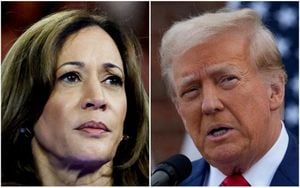The recent midterm elections have stirred feelings of optimism and disappointment across the United States, with several races yielding surprising outcomes. Democrats have made gains, particularly evident in the state of Connecticut, where they secured additional seats within the House of Representatives. House Speaker Matthew Ritter expressed satisfaction with these results, declaring it "a good day for Democrats." With the party now holding 102 out of 151 seats, the focus shifts to close races which could alter the political map even more. The anticipation rests on districts such as the 59th and 65th, where the counting of early ballots continues.
Meanwhile, not all Democratic candidates found success. A notable loss came from Ohio, where veteran Senator Sherrod Brown faced defeat at the hands of newcomer Bernie Moreno. Brown, who has served nearly five decades, was edged out as Ohio swung toward Republicans, carrying out their ticket sweep, including Donald Trump's influence. Moreno capitalized on this environment, defeating Brown by approximately four percentage points—an outcome triggering reflection on Brown's previous accolades and political strategies over the decades.
Brown's reliance on his reputation as a champion of the working class was not enough as the political tides shifted dramatically since elections past. Former Ohio Governor Bob Taft's mixed endorsement of Brown underscored the respect Brown commanded, yet it wasn't sufficient to fend off the Republican onslaught this election season. Moreno’s campaign, backed by Trump and Senator J.D. Vance, effectively painted Brown as too liberal for Ohio’s changing demographic, employing aggressive financial backing alongside impactful media campaigns.
The total spending for these campaigns broke historic records, marking the Brown-Moreno race as the most expensive non-presidential contest with nearly $500 million shelled out. Facing personal attacks—some of which mischaracterized his views—Brown’s teams made efforts to set the record straight but couldn't control the narrative, reflecting how media strategies are becoming increasingly significant.
This election showcased the pivotal role close races play, with both parties now reflecting on their strengths and weaknesses. Republicans have claimed wins but will face internal challenges moving forward. While Democrats celebrate their gains, many will look toward new leadership dynamics, especially as the party begins to navigate the path to 2024. There’s potential for leadership changes, with upcoming caucuses expected from both party leaderships.
Democrats aiming for cohesion will need to strategize around the voices of diverse districts. House Speaker Ritter emphasized the diversity among their new members, which may provide the key to winning more citizens across party lines. Keeping the local conversations relevant and personal could bridge gaps and maintain political engagement, fulfilling vows to serve communities more deeply.
Simultaneously, the looming uncertainties and contests arise once more, particularly highlighting how newly elected officials approach governance. The aim for any successful strategy will center on listening to constituents as they shape policies and proposals.”
While Ohio reflects broader shifts, Connecticut showcases localized victories for Democrats, resembling how different states reacted uniquely to national trends. The apparent contrasts affirm how state dynamics often defy overarching political narratives. The multifaceted nature of the results demonstrates diverse reactions among constituents to various political issues, like economic recovery and social justice.
These midterms have set the stage for upcoming national conversations. Politicians from both parties will reflect on results, learning from voters’ insights and possibly recalibrations for the future. With growing involvement from various political action committees and grassroots movements, the Democratic Party could be assured of support from within local communities, building on what they’ve established over the past election.
Looking toward 2024, both parties brace for intensified campaigning as they unpack the outcomes and plan for what’s next. The engagement and mobilization of voters remain pivotal, fueling discussions around policy initiatives, remedies for economic growth, and social welfare reforms. Overall, how parties adapt to the findings of these elections will significantly affect the larger national discourse going forward.
With one eye on the changing tides of public opinion and another on leadership strategies, these midterm results reveal much about the current state of politics across the nation. The stakes are high as political players recalibrate their approaches, keeping one goal central: ensuring their constituents feel represented.



